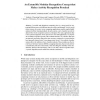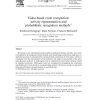2001 search results - page 9 / 401 » Semantic Activity Recognition |
KI
2010
Springer
13 years 5 months ago
2010
Springer
Abstract. In mobile and ubiquitous computing, there is a strong need for supporting different users with different interests, needs, and demands. Activity recognition systems for c...
CVIU
2004
13 years 7 months ago
2004
We present a new representation and recognition method for human activities. An activity is considered to be composed of action threads, each thread being executed by a single act...
ICRA
2009
IEEE
13 years 5 months ago
2009
IEEE
In this paper, we propose a human daily activity recognition method by fusing the data from two wearable inertial sensors attached on one foot and the waist of the human subject, r...
DOOD
1995
Springer
13 years 11 months ago
1995
Springer
Semantics represents a major problem area for active databases inasmuch as (i) there is l framework for defining the abstract semantics of active rules, and (ii) the various syst...
MODELS
2010
Springer
13 years 5 months ago
2010
Springer
Abstract. UML activity diagrams have become an established notamodel control and data flow on various levels of abstraction, ranging from fine-grained descriptions of algorithms ...


